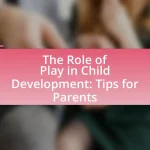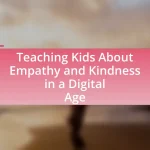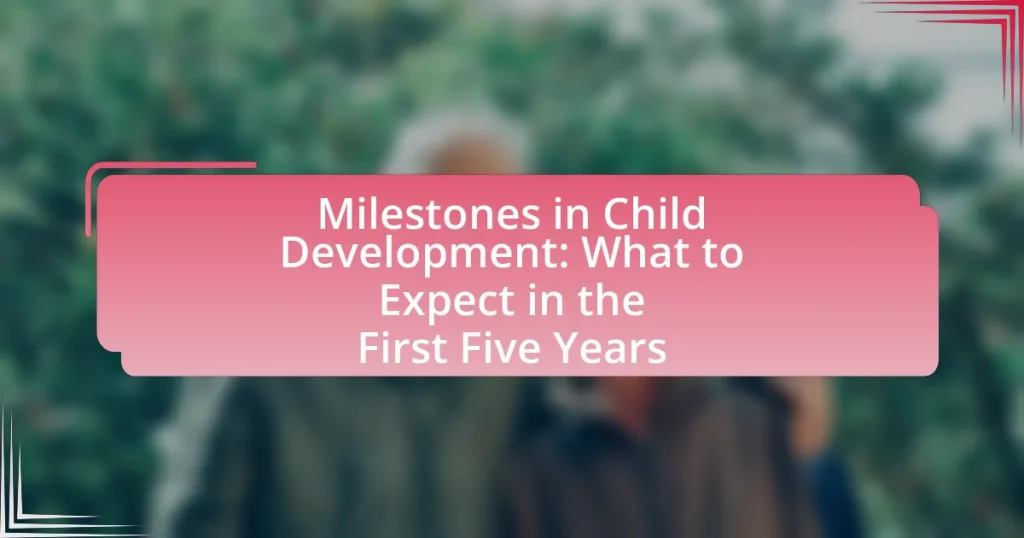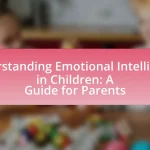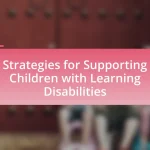The article focuses on the key milestones in child development during the first five years, detailing significant physical, cognitive, social, and emotional growth. It outlines expected developmental achievements at various ages, such as gross and fine motor skills, language acquisition, and social interactions, supported by guidelines from reputable organizations like the CDC and AAP. Additionally, the article emphasizes the importance of understanding these milestones for early intervention, addressing common concerns regarding developmental delays, and providing practical tips for parents to support their child’s growth effectively.

What are the key milestones in child development during the first five years?
Key milestones in child development during the first five years include significant physical, cognitive, social, and emotional growth. By the end of the first year, infants typically can sit up, crawl, and may begin to walk. At age two, toddlers often can run, climb, and use simple sentences. By age three, children usually can engage in imaginative play, follow simple instructions, and have a vocabulary of around 200 words. At four years old, children often can count, recognize some letters, and play cooperatively with peers. By age five, most children can write their name, understand the concept of time, and demonstrate more complex social interactions. These milestones are supported by developmental guidelines from organizations such as the Centers for Disease Control and Prevention (CDC) and the American Academy of Pediatrics (AAP), which outline expected behaviors and skills at each age.
How do physical milestones manifest in early childhood?
Physical milestones in early childhood manifest through a series of developmental stages that include gross and fine motor skills. Infants typically begin by gaining head control, rolling over, and sitting up by six months. By the age of one, many children can stand and take their first steps, showcasing their ability to coordinate larger muscle groups. As they progress to two years, toddlers often demonstrate improved balance and coordination, enabling them to run, climb, and kick a ball. Fine motor skills also develop, allowing children to grasp small objects, use utensils, and engage in simple drawing activities. Research indicates that these milestones are crucial indicators of overall development, with the Centers for Disease Control and Prevention (CDC) providing specific age-based guidelines to track these physical achievements.
What are the typical gross motor skills developed by age one?
By age one, typical gross motor skills include sitting without support, crawling, pulling up to stand, and taking a few steps while holding onto furniture. These skills demonstrate significant physical development and coordination. Research indicates that most infants achieve these milestones within the first year, reflecting their growing strength and balance as they transition from immobility to independent movement.
How do fine motor skills progress from ages one to five?
Fine motor skills progress significantly from ages one to five, evolving from basic grasping to intricate hand-eye coordination. At age one, children typically exhibit a palmar grasp, using their whole hand to hold objects. By age two, they refine their skills to a more controlled pincer grasp, allowing them to pick up smaller items like peas. At three years old, children can manipulate toys with greater precision, such as turning knobs and stacking blocks. By age four, they begin to use scissors and can draw simple shapes, demonstrating improved dexterity. Finally, by age five, children can perform tasks like writing their names and using utensils effectively, showcasing advanced fine motor coordination. This progression aligns with developmental milestones outlined by the American Academy of Pediatrics, which emphasizes the importance of these skills in overall child development.
What cognitive milestones should parents expect?
Parents should expect several key cognitive milestones in their child’s development during the first five years. By the age of 2, children typically demonstrate the ability to follow simple instructions and engage in parallel play, indicating emerging problem-solving skills. At age 3, they often begin to engage in imaginative play and can sort objects by shape and color, reflecting their growing understanding of categories. By age 4, children usually can count to four or five and understand the concept of “same” and “different,” showcasing their developing numerical and comparative reasoning. By age 5, most children can recognize some letters and numbers, and they start to understand the concept of time, indicating significant cognitive growth. These milestones are supported by developmental research, such as the guidelines provided by the American Academy of Pediatrics, which outlines expected cognitive skills at various ages.
How does problem-solving ability evolve in the first five years?
Problem-solving ability evolves significantly during the first five years of a child’s life. In the first year, infants demonstrate basic problem-solving through trial and error, such as reaching for toys just out of reach. By age two, toddlers begin to use simple strategies, like stacking blocks or using objects as tools, indicating an understanding of cause and effect. Between ages three and five, children develop more complex problem-solving skills, including the ability to plan ahead, think abstractly, and engage in cooperative play, which fosters social problem-solving. Research by the American Psychological Association highlights that these developmental milestones are crucial for cognitive growth, as children learn to navigate challenges and develop critical thinking skills.
What role does language development play in cognitive milestones?
Language development is crucial for achieving cognitive milestones as it facilitates critical thinking, problem-solving, and social interaction. As children acquire language skills, they enhance their ability to categorize, analyze, and communicate their thoughts, which are essential components of cognitive development. Research indicates that children who develop language skills early tend to perform better on cognitive tasks, such as memory and reasoning, as they can articulate their understanding and engage in more complex thought processes. For instance, studies have shown that vocabulary size at age two is a strong predictor of later academic success, highlighting the direct link between language proficiency and cognitive advancement.
How do social and emotional milestones develop in early childhood?
Social and emotional milestones in early childhood develop through a series of stages that reflect a child’s growing ability to interact with others and understand their own emotions. During the first year, infants begin to form attachments, showing preferences for caregivers and responding to social stimuli, which is crucial for emotional security. By age two, toddlers exhibit increased independence, engage in parallel play, and start to express a wider range of emotions, including empathy. Research indicates that by age three, children begin to understand social norms and can engage in cooperative play, which further enhances their social skills. These milestones are supported by developmental theories, such as Erik Erikson’s stages of psychosocial development, which emphasize the importance of social interactions in shaping emotional growth.
What are the signs of social skills development by age two?
By age two, signs of social skills development include parallel play, where children play alongside others without direct interaction, and the ability to express emotions such as joy, frustration, or anger. Additionally, children at this age may show interest in other children, engage in simple turn-taking games, and begin to use words or gestures to communicate their needs and feelings. Research indicates that these behaviors are critical indicators of social development, as they reflect a child’s growing understanding of social interactions and relationships.
How do emotional regulation skills change from ages three to five?
Emotional regulation skills develop significantly between ages three and five. At age three, children typically exhibit basic emotional responses and may struggle to manage their feelings, often expressing emotions through tantrums or crying. By age five, children begin to demonstrate improved emotional regulation, showing the ability to identify their emotions, use coping strategies, and communicate their feelings more effectively. Research indicates that this progression is linked to cognitive development, social interactions, and increased language skills, which enhance their ability to understand and manage emotions. For instance, a study by Denham et al. (2012) highlights that children who engage in social play and receive emotional support from caregivers show greater emotional regulation abilities as they approach age five.
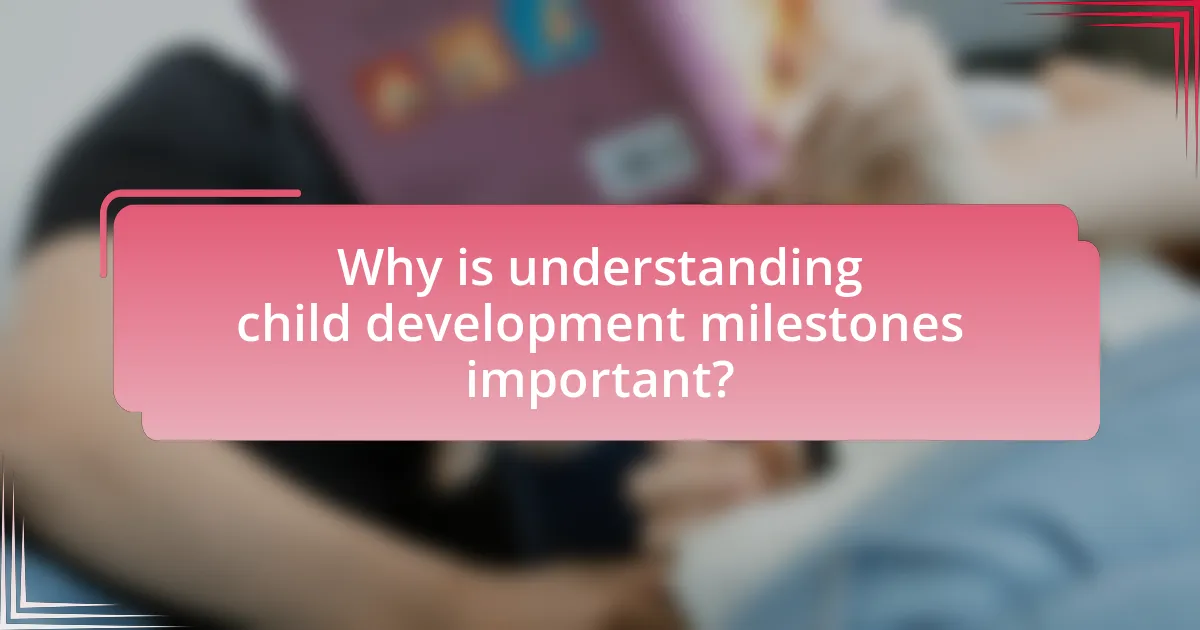
Why is understanding child development milestones important?
Understanding child development milestones is important because they provide a framework for assessing a child’s growth and development. These milestones help parents, educators, and healthcare professionals identify typical developmental patterns and recognize potential delays or concerns early on. Research indicates that early intervention can significantly improve outcomes for children who may be at risk for developmental issues, as highlighted in a study published in the Journal of Pediatrics, which found that timely support can enhance cognitive and social skills in children.
How can knowledge of milestones aid in early intervention?
Knowledge of developmental milestones aids in early intervention by providing benchmarks for assessing a child’s growth and identifying delays. These milestones, such as walking, talking, and social interactions, serve as critical indicators of typical development. Research indicates that early identification of developmental delays can lead to timely interventions, which significantly improve outcomes. For instance, a study published in the journal “Pediatrics” found that children who received early intervention services showed greater improvements in cognitive and social skills compared to those who did not. Thus, understanding milestones enables caregivers and professionals to recognize when a child may need additional support, facilitating prompt and effective intervention strategies.
What are the benefits of identifying developmental delays early?
Identifying developmental delays early allows for timely interventions that can significantly improve a child’s long-term outcomes. Early identification facilitates access to specialized services, such as speech therapy or occupational therapy, which can enhance developmental skills and mitigate further delays. Research indicates that children who receive early intervention show greater improvements in cognitive, social, and emotional development compared to those who do not receive such support. For instance, a study published in the journal “Pediatrics” found that early intervention programs can lead to a 50% increase in developmental skills in children with identified delays. This proactive approach not only supports the child’s growth but also alleviates potential challenges in educational settings and social interactions later in life.
How can parents support their child’s development based on milestones?
Parents can support their child’s development based on milestones by actively engaging in age-appropriate activities that promote skills such as communication, motor abilities, and social interaction. For instance, during the first year, parents can encourage language development by talking, reading, and singing to their child, which has been shown to enhance vocabulary and comprehension skills. Research indicates that children exposed to rich language environments demonstrate better language outcomes (Hart & Risley, 1995).
As children reach the toddler stage, parents can facilitate physical development by providing safe spaces for exploration and play, which is crucial for developing gross and fine motor skills. Engaging in activities like stacking blocks or drawing can significantly enhance hand-eye coordination and dexterity.
In preschool years, parents can support social-emotional development by encouraging playdates and group activities, fostering skills like sharing and cooperation. Studies show that children who engage in social play are better equipped to handle interpersonal relationships later in life (Ladd, 1999).
By understanding and responding to developmental milestones, parents can create supportive environments that nurture their child’s growth effectively.
What resources are available for tracking child development?
Resources available for tracking child development include developmental milestone checklists, pediatrician assessments, and online tools such as the CDC’s “Milestone Tracker” app. Developmental milestone checklists provide specific age-related skills and behaviors that children typically exhibit, allowing parents and caregivers to monitor progress. Pediatricians conduct regular assessments during well-child visits to evaluate a child’s growth and development, offering professional insights. The CDC’s “Milestone Tracker” app allows parents to track their child’s milestones, receive reminders for developmental screenings, and access resources tailored to their child’s age, reinforcing the importance of early detection and intervention.
How can developmental checklists assist parents and caregivers?
Developmental checklists assist parents and caregivers by providing a structured framework to monitor a child’s growth and developmental milestones. These checklists outline specific skills and behaviors expected at various ages, enabling caregivers to identify areas where a child may be excelling or lagging behind. Research indicates that early identification of developmental delays can lead to timely interventions, which significantly improve outcomes for children. For instance, the Centers for Disease Control and Prevention (CDC) emphasizes that regular developmental screenings can help detect issues early, allowing for appropriate support and resources to be provided.
What role do pediatricians play in monitoring milestones?
Pediatricians play a crucial role in monitoring developmental milestones in children. They assess physical, cognitive, and emotional growth during regular check-ups, ensuring that children meet age-appropriate milestones such as walking, talking, and social interactions. Pediatricians utilize standardized developmental screening tools, such as the Ages and Stages Questionnaires, to identify any delays or concerns early on. This proactive approach allows for timely interventions, which can significantly improve outcomes for children who may be at risk for developmental disorders.
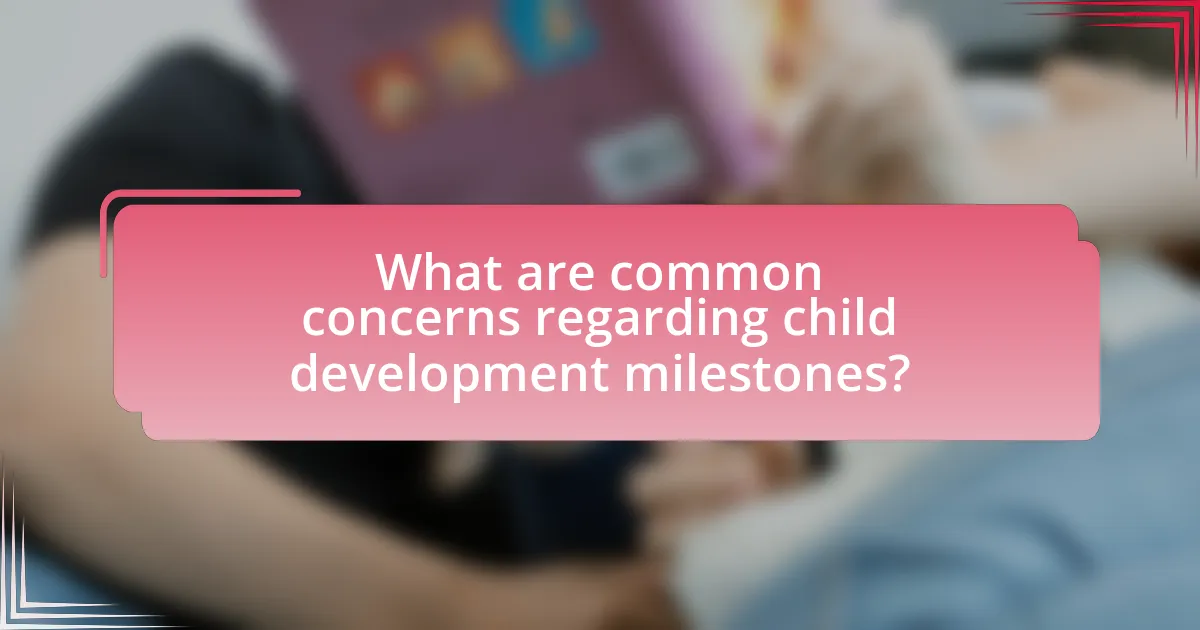
What are common concerns regarding child development milestones?
Common concerns regarding child development milestones include delays in speech, motor skills, and social interactions. Parents often worry if their child is not meeting expected milestones, such as not walking by 15 months or not speaking simple words by age two. Research indicates that approximately 1 in 6 children experience developmental delays, highlighting the importance of early intervention. Pediatric guidelines suggest monitoring these milestones closely, as early detection can lead to better outcomes in development and learning.
What should parents do if they notice delays in milestones?
Parents should consult a pediatrician if they notice delays in their child’s developmental milestones. Early intervention is crucial, as research indicates that addressing developmental delays promptly can significantly improve outcomes. The Centers for Disease Control and Prevention (CDC) emphasizes that developmental screenings can help identify potential issues, allowing for timely support and resources.
How can parents approach discussions about concerns with healthcare providers?
Parents can approach discussions about concerns with healthcare providers by preparing specific questions and documenting observations related to their child’s development. This preparation allows parents to communicate effectively and ensures that they address their concerns clearly. Research indicates that parents who actively engage in discussions with healthcare providers are more likely to receive tailored advice and support, enhancing their child’s developmental outcomes. For instance, a study published in the Journal of Pediatrics highlights that effective communication between parents and healthcare providers leads to improved understanding of developmental milestones and timely interventions.
What are the next steps if a developmental assessment is recommended?
If a developmental assessment is recommended, the next steps involve scheduling the assessment with a qualified professional, such as a pediatrician or child psychologist. This assessment typically includes standardized tests and observational evaluations to identify any developmental delays or concerns. Following the assessment, the professional will provide a detailed report outlining the findings and recommendations for interventions or support services if needed. Research indicates that early identification and intervention can significantly improve developmental outcomes for children, making timely assessments crucial.
What are some myths surrounding child development milestones?
Some common myths surrounding child development milestones include the belief that all children develop at the same pace and that missing a milestone indicates a serious problem. Research shows that while there are general timelines for milestones, individual differences are normal, with many children reaching milestones earlier or later than average without any underlying issues. Additionally, the idea that children must achieve specific milestones by a certain age can create unnecessary pressure; studies indicate that developmental variability is common and often not a cause for concern.
How can misinformation impact parental expectations and child development?
Misinformation can significantly distort parental expectations and negatively affect child development. When parents rely on inaccurate information regarding developmental milestones, they may set unrealistic expectations for their child’s growth, leading to undue stress and anxiety for both the parent and child. For instance, a study published in the journal “Child Development” found that parents who believed in myths about early childhood development were more likely to misinterpret their child’s behavior and developmental progress, which can hinder appropriate support and intervention. This misalignment can result in delayed developmental outcomes, as children may not receive the necessary encouragement or resources to thrive.
What are the facts that counter common myths about milestones?
Common myths about developmental milestones often suggest that all children achieve them at the same age, but research indicates that there is a wide range of normal development. For instance, while many children walk by 12 months, some may not walk until 15 or even 18 months, and this variation is considered typical. Additionally, the myth that children should be able to speak in full sentences by age two is countered by evidence showing that many children communicate effectively through single words or phrases at that age. Furthermore, the belief that missing a milestone indicates a serious problem is misleading; many children catch up over time without intervention. Studies, such as those published in the Journal of Pediatrics, emphasize that developmental timelines are not rigid and that individual differences are common.
What practical tips can help parents support their child’s development?
Parents can support their child’s development by engaging in interactive play, providing a nurturing environment, and encouraging exploration. Interactive play, such as reading together or playing educational games, enhances cognitive and language skills. A nurturing environment, characterized by emotional support and consistent routines, fosters security and promotes social-emotional development. Encouraging exploration allows children to develop problem-solving skills and creativity, which are crucial during the formative years. Research indicates that children who experience rich interactions and supportive environments demonstrate better developmental outcomes, including improved language abilities and social skills.
How can daily routines enhance developmental progress?
Daily routines enhance developmental progress by providing structure and predictability, which are essential for a child’s emotional and cognitive growth. Consistent daily activities, such as mealtime, playtime, and bedtime, help children develop a sense of security and understanding of time, which fosters their ability to learn and adapt. Research indicates that children who engage in regular routines exhibit improved language skills and social behaviors, as these routines often involve interaction and communication with caregivers. For instance, a study published in the journal “Child Development” found that children with structured routines showed higher levels of self-regulation and better academic performance.
What activities promote physical, cognitive, and social skills in young children?
Activities that promote physical, cognitive, and social skills in young children include structured play, interactive games, and creative arts. Structured play, such as obstacle courses, enhances physical coordination and strength, while interactive games like Simon Says foster cognitive skills through listening and following directions. Creative arts, including drawing and music, stimulate cognitive development and encourage social interaction when children collaborate on projects. Research indicates that engaging in these activities supports holistic development, as children learn to navigate their physical environment, think critically, and build relationships with peers.

